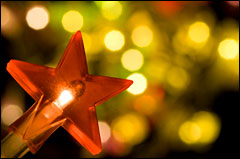Dear Umbra,
As the holiday season approaches, I’m trying to figure out how to spread good cheer in home decorations while being sensitive to the environment. Years ago, my husband and I purchased strings of lights that we wrapped around the trunks of palm trees in our front yard. Now the wiser, I’d like to use these lights off the grid, if you will. Instead of purchasing new LED lights that are so popular right now (and in turn, promoting more consumerism!), do you know of a solar panel that has an electrical outlet? I’m thinking that I could charge the panel during the day (here in sunny Southern California) and plug in the lights at night to show our holiday spirit. Has technology caught up to this yet, or do I just have a million-dollar idea?
Ashley Bradley
San Diego, Calif.
Dearest Ashley,
Here I am all excited about your solar light show, and then I notice your home is in sunny San Diego. I hope you still have a home and trees in front of it, and that this column finds you fire-free.

Twinkle, twinkle little star, how I wonder
how green you are.
Photo: iStockphoto
I’m trying to write about Holiday Issues early this year, give you all some lead time should you wish to investigate my investigations. (Or is that LED time? Ho ho ho!) You do have a million-dollar idea: a great idea, but prohibitively expensive. There are readily available alternatives; you’ll just have to cave and buy those incredibly efficient LED lights you meant to avoid, with a solar cell built in.
Here’s the deal: photovoltaic cells, which make up the familiar flat, shiny solar panels, produce direct current (DC). American household appliances run on alternating current (AC). Solar electricity captured to power home appliances must first pass through an inverter, which converts the current from DC to AC. In order to achieve your imagined holiday light scenario, you would need to buy a panel and an inverter, and I suppose a receptacle (unless I’m missing something out in the solar universe, which is always possible). There are holiday lights available that plug directly into DC current, but their plug-ends are adapters such as fit in a car cigarette lighter. All this would be ridiculously expensive, bringing the obvious question to the fore: if you are going to do all that just to power incandescent holiday lights, why not start changing over to solar power for your entire home?
Luckily, you have some time to start planning your home’s solar conversion, because there are solar holiday lighting possibilities that don’t require rush-job rooftop solar arrays. Plenty of solar-cell powered holiday lighting décor is already on the market. These seem to work on the same principle as solar roadside emergency boxes: a small, built-in solar cell provides the power, and daylight charges a battery that is then drained by the night’s holiday cheer.
The lamps in the lights are usually LED, because LED lights are far, far more efficient than incandescents. A string of solar-powered LED lights might cost $60-$100 or more — which seems expensive, until we recall how expensive an entire solar array would have been. The one-time expense may also be leavened by the money you’ll save on your electric bill.
Solar-powered holiday products include strings of lights, wreaths, little Santa heads on a stick, snowpersons, entire mini-trees, and fake candles-in-a-bag. You will easily find all of these and more right here on the worldwide web, and I think you’ll be very happy with the money you’ll save. Keep the holiday questions coming, I’m braced and ready.
Cheerily,
Umbra


